Structured teaching is an intervention philosophy developed by the University of North Carolina, Division TEACCH (Treatment and Education of Autistic and related Communication Handicapped Children). . Structured teaching is an approach in instructing children with autism. It allows for implementation of a variety of instructional methods (e.g., visual support strategies, Picture Exchange Communication System – PECS, sensory integration strategies, discrete trial, music/rhythm intervention strategies, Greenspan’s Floortime, etc.). The following information outlines some important considerations for structured teaching to occur. It is one of many approaches to consider in working with children with autism.
Eric Schopler, founder of Division TEACCH in the early 1970’s, established the foundation for structured teaching in his doctoral dissertation (2) by demonstrating that people with autism process visual information more easily than verbal information.
What is Structured Teaching (1)
Structured teaching is based upon an understanding of the unique features and characteristics associated with the nature of autism.
Structured teaching describes the conditions under which a person should be taught rather than “where” or “what” (i.e., “learning how to learn”).
Structured teaching is a system for organizing their environments, developing appropriate activities, and helping people with autism understand what is expected of them.
Structured teaching utilizes visual cues which help children with autism focus on the relevant information which can, at times, be difficult for the person with autism to distinguish from the non-relevant information.
Structured teaching addresses challenging behaviors in a proactive manner by creating appropriate and meaningful environments that reduce the stress, anxiety and frustration which may be experienced by children with autism. Challenging behaviors may occur, due to (the following characteristics of autism:
- Language comprehension difficulties
- Expressive language difficulties
- Social relations difficulties
- Sensory processing difficulties
- Resistance to change
- Preference for familiar routines and consistency
- Organizational difficulties
- Difficulty attending to relevant stimuli
- Distractibility
Structured teaching greatly increases a child’s independent functioning (i.e., without adult prompting or cueing) which will assist him throughout life.
This article will address the features of a structured teaching approach. It is important to remember that to effectively use the features of this approach, the individual’s strengths and needs must be taken into consideration.
Primary Components of Structured Teaching:
-
Physical Structure
-
Visual Schedules
-
Teaching Method
Physical Structure
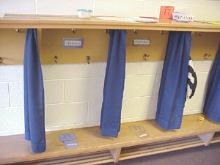
Definition: Physical structure refers to the way in which we set up and organize the person’s physical environment: It emphasizes where/how we place the furniture and materials (1) in the various environments including classrooms, playground, workshop/work area, bedroom, hallways, locker/cubby areas, etc.
Close attention to physical structure is essential for a number of reasons:
- Physical structure provides environmental organization for people with autism.
- Clear physical and visual boundaries help the person to understand here each area begins and ends.
- The physical structure minimizes visual and auditory distractions.
The amount of physical structure needed is dependent on the level of self-control demonstrated by the child, not his cognitive functioning level. As students learn to function more independently, the physical structure can be gradually lessened (5).
Example: A high functioning child with autism may display limited self control. He will need a more highly structured environment than a lower functioning child displaying better self control.
Physical structure consists of a number of components:
- Location: Physical structure should be considered in any environment in which the person with autism interacts, including classrooms, playground, workshop/work area, bedroom, hallways, locker/cubby areas, etc.

- Design/Layout.
- Clear visual and physical boundaries: Each area of the classroom (or environment) should be clearly, visually defined through the arrangement of furniture (e.g., bookcases, room, dividers, office panels, shelving units, file cabinets, tables, rugs, etc.) and use of boundary markers, such as carpet squares or colored floor tape. Children with autism typically do not automatically segment their environments like typically developing children. Large, wide-open areas can be extremely difficult for children with autism to understand:
- What is to occur in each area
- Where each area begins and ends
- How to get to a specific area by the most direct route.
- Clear visual and physical boundaries: Each area of the classroom (or environment) should be clearly, visually defined through the arrangement of furniture (e.g., bookcases, room, dividers, office panels, shelving units, file cabinets, tables, rugs, etc.) and use of boundary markers, such as carpet squares or colored floor tape. Children with autism typically do not automatically segment their environments like typically developing children. Large, wide-open areas can be extremely difficult for children with autism to understand:
By strategically placing furniture to clearly visually define specific areas, it will decrease the child’s tendency to randomly wander/run from area to area. Visual physical boundaries can also be further defined within a specific area.
Example: During group story time, a carpet square or taped-off square can provide the child with autism clear visual cues as to the physical boundaries of that activity. Floor tape can also be used in gym class to indicate to the child with autism the area in which he should stay to perform certain motor skills, like warm-up exercises.
Example: Color coded placements (according to each child’s assigned color) can be used for snack or mealtimes. The placements will visually and physically define each child’s “space” (and food items) on the table.
These visual cues will help children with autism better understand their environment, as well as increase their ability to become more independent in their environment and less reliant on an adult for direction.
- Minimize visual and auditory distractions: Visual distractions can be minimized:
- By painting the entire environment (walls, ceilings, bulletin boards, etc.) a muted color (e.g., off-white)
- By limiting the amount of visual “clutter” which is typically present in most classrooms in the form of art projects, seasonal decorations and classroom materials
- By placing sheets/curtains to cover shelves of classroom materials, as well as other visually distracting equipment (e.g., computer, copy machine, TV/VCR, etc.)
- By storing unnecessary equipment/materials in another area
Example: In the play area, limit the number of appropriate toys which the children can use and then, on a weekly basis, rotate in “new” toys, while putting away the “old” ones.
- Through the use of natural lighting from windows to reduce visually distracting fluorescent lighting
- By controlling the amount of light through the use of blinds, curtains, or shades, thus creating a warm and calm environment
- By placing study carrells and individual student work areas, bordered by a wall or corner of the classroom, away from group work tables can also reduce environmental visual distractions
- By carefully considering where the child with autism will sit in the regular education classroom.
Example: Tony, a student with autism was seated in the front of the class, facing away from the door or windows and away from shelves with instructional materials in order to minimize visual distractions.
- Auditory distractions can be reduced through the use of carpeting, lowered ceilings, acoustical tiles, P.A. system turned off (or covered with foam to mute the sound) and headphones for appropriate equipment, such as the computer or tape players.
- Develop appropriate instructional, independent, recreation and leisure areas in each physically structured environment.
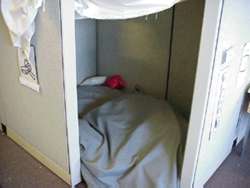
In a classroom setting, these areas may include:
- Small group work area
- Independent work area
- 1:1 work area
- Play/recreation/leisure area
- Sensory motor area
- Crash/quiet area
At home, these areas may include:
- An independent work area
- Play area
- Crash/quiet area
Again, these specific areas should have clear visual boundaries to define each area for the child with autism. It is also important to keep in mind the various distractions which may be present in each area, and make accommodations accordingly.
- Organization: A physically structured environment must be extremely organized to effectively implement a structured teaching approach. Adequate storage of various materials (not in view of the students), which can also be easily accessed by the adults in the environment, is critical.
Example: A sectioned-off storage area (with high dividing units to keep materials out of sight of the students) within the classroom can be very helpful to keep the environment “clutter and distraction-free” yet provide easy access to needed materials.
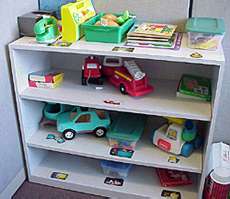
Students with autism can also be taught to keep the physical environment structured and organized through the use of pictures, color-coding, numbers, symbols, etc.
Example: In the play area, pictures of the toys can be placed on the shelves to provide structure when putting things away.
.
.
.
Visual Schedules
Definition: A daily visual schedule is a critical component in a structured environment. A visual schedule will tell the student with autism what activities will occur and in what sequence.
Visual schedules are important for children with autism because they:
- Help address the child’s difficulty with sequential memory and organization of time.
- Assist children with language comprehension problems to understand what is expected of them (5).
- Lessen the anxiety level of children with autism, and thus reduce the possible occurrence of challenging behaviors, by providing the structure for the student to organize and predict daily and weekly events.
- Schedules clarify that activities happen within a specific time period (e.g., understanding that “break time” is coming, but after “work time”), and also alert the student to any changes that might occur.
- Assist the student in transitioning independently between activities and environments by telling them where they are to go next (5). Visual schedules can be used in all environments (e.g., classroom, gym, Occupational Therapy, Speech/Language Therapy, home, Sunday School, etc.).
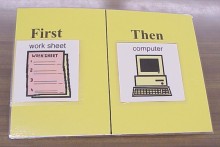
- Are based on a “first-then” strategy; that is, “first you do ___, then you do ___”, rather than an “if-then” approach (i.e., “if you do ___, then you can do___”). This first-then strategy allows the “first” expectation (whether a task, activity or assignment) to be modified, as needed. The modification is in terms of task completion and amount of prompting, in order to accommodate the student’s daily fluctuations in his ability to process in-coming information. Then he can move on to his next visually scheduled task/activity.
Example: A student is having particular difficulty completing a math worksheet, due to anxiety, sensory processing difficulties, communication, difficulty generalizing, internal/external distracters, change, etc. The assignment can be modified so that the child only has to complete three math problems first, and then he has a sensory break, as indicated on his visual schedule.
- Can incorporate various social interactions into the student’s daily schedule (e.g. showing completed work to a teacher/parent for social reinforcement, requiring appropriate social greetings).
- Can increase a student’s motivation to complete less desired activities by strategically alternating more preferred with less-preferred activities on the student’s individual visual schedule.
Example: By placing a “computer” time after “math”, the student may be more motivated to complete math knowing that “computer” time will be next.
- A visual schedule for a student with autism must be directly taught and consistently used. Visual schedules should not be considered as “crutches” for students with autism, from which they should gradually be “weaned”. Instead, these individual visual schedules should be considered as “prosthetic” or “assistive tech” devices. For the student with autism, the consistent use of a visual schedule is an extremely important skill. It has the potential to increase independent functioning throughout his life – at school, home and community.
- Developing Visual Schedules: In general, schedules should be arranged from a “top-to-bottom” or “left-to-right” format, including a method for the student to manipulate the schedule to indicate that an activity is finished or “all done” .
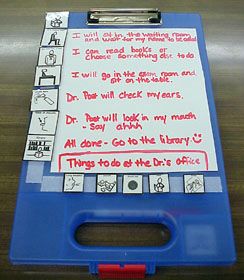
Example: Cross/mark off with a dry erase marker, place the item in an “all done” envelope/box, check off the item, draw a line through the scheduled activity, etc.
- A minimum of two scheduled items should be presented at a time so that the student begins to understand that events and activities happen in a sequential manner, not in isolation.
- Schedules can be designed using a variety of formats, depending upon the needs of the individual student.
Example: Object schedule, 3 ring binder schedule, clipboard schedule, manila file folder schedules, dry erase board schedules, Velcro strip across the top of the desk, etc.
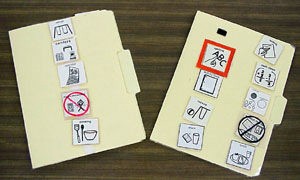
Various visual representation systems can be used for an individual visual schedule including:
- Real objects
- Photographs (e.g., “Picture This” software program or own photos)
- Realistic drawings
- Commercial picture system (e.g., “Boardmaker” software program)
- Written words/lists.
Individual Schedule: It is necessary to develop an individual schedule for the child with autism in addition to the general classroom schedule.
- An individual schedule will give the child with autism important information in a visual form that he can readily understand.
- Another consideration when individualizing a schedule for a student with autism is the length of the schedule (number of activities). The length of the schedule may need to be modified due to the student becoming increasingly obsessed and/or anxious regarding an up-coming scheduled activity, or due to difficulty in processing “too much” information presented at once.
Example: A particular student “obsesses” over recess. If at the beginning of his day he sees “recess” scheduled later in the morning, he will continue to be obsessed with “going out for recess”, resulting in increased anxiety and distractibility for the rest of the morning activities until recess. The student’s schedule could be created with a few activity items at a time, up until recess. Again, individualization is the key to success.
Check Schedule. Some students may need a “check schedule” visual physical prompt to teach them to independently check their schedule, as well as learn the importance of their schedule. Example: “Check schedule” visual prompts can be made by writing the student’s name on laminated colored paper strips or using popsicle sticks or poker chips with a large check printed on the chip, etc.
The “check schedule” prompts are visual and physical cues (as opposed to adult prompts) given to the student for any transition in his daily activities, to cue him to check his schedules.
A child who relies too heavily on adult prompts rather than using “check schedule” prompts in with his schedule, may have more difficulty understanding the importance of his schedule and have limited success in using it.
Transitions. Some students may need to transition to the next scheduled activity by taking their scheduled item (card or object) off their individual schedule and carrying this with them to the next activity/location. This may be due to the child’s increased distractibility in maneuvering through the environment. The distractibility, or inability to sustain attention throughout the transition, is independent of the child’s cognitive functioning level or verbal skills.
Example: Some non-verbal students with autism, who function at a younger cognitive level, do not require transition schedule cards to get to the next scheduled activity. On the other hand certain higher functioning students with autism require a transition card to get to the next scheduled activity, due to their increased distractibility.
Teaching Components
Teaching components include Work Systems and Visual Structure.
Work Systems, refers to the systematic and organized presentation of tasks/materials in order for students to learn to work independently, without adult directions/prompts. It is important to note that “work systems” can reflect any type of task(s) or activities (e.g., academic, daily living skills, recreation and leisure, etc.). Each “work system”, regardless of the nature of the specific task or activity, should address the following four questions:
What is the work to be done? What is the nature of the task? (e.g., sorting by colors; adding/subtracting 2 digit numbers, making a sandwich, brushing teeth, etc.).
How much work? Visually represent to the student exactly how much work is to be done. If the student is to cut out only 10 soup can labels, don’t give him a whole stack and expect him to independently count and/or understand that he is to cut out only 10 soup can labels, for the task to be considered complete. Seeing the whole stack of labels – even if told that he is going to cut only ten – can cause a child with autism a great deal of frustration and anxiety in not being able to understand exactly how much work to complete.
Remember, students with autism rely upon their visual channel to process information; therefore, seeing a whole stack of work to complete can prove overwhelming. Provide only the materials the student will need for the specific task/activity in order to decrease his possible confusion in understanding exactly how much and what work is to be done.
When am I finished? The student needs to independently recognize when he is finished with a task/activity. The task itself may define this, or the use of timers or visual cues, such as a red dot, to indicate where to stop on a particular worksheet, has proven effective.
What comes next? Items such as physical reinforcers, highly desired activities, break times or free choice are highly motivating toward task completion. In some cases, being “all done” with the task motivates the child enough to complete it.
Experience with structured teaching and the use of “work systems” has shown that a student’s overall productivity increases when the student has a way of knowing how much work there is to do, as well as when it is to be finished (1). Use of a “work system” helps to organize the child with autism through use of a structured and systematic approach to completing various tasks independently.
Examples of various types of work systems, from easiest to most difficult, include:
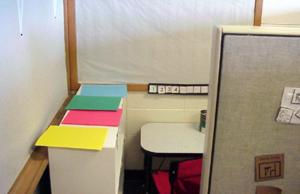
Left to right sequence – finished box/basket/folder to the far right. This is the most concrete level of “work systems” and involves placing items to be completed to the left of the person’s workspace (e.g., a shelf, folder, basket/tub, etc.). The student is taught to take the items from the left, complete them at his work space in front of him, and then place the completed work to the right in an “all done” box, folder, basket, etc.
Matching – color, shape, alphabet, number. This would be a higher level skill in that the person must complete his “work jobs” in a sequential order by matching color, shape, alphabet letter or number coding system.
Example. The student has a sequence strip of individual numbers 1-10 velcroed on their desk/work space. He also has multiple “work jobs” located on his left. To complete tasks in this work system (matching), he takes the number “1” off his number strip and matches it to the number “1” located on one of the work jobs. This is the job/task/activity he must complete first. He continues matching numbers to tasks in order to complete those tasks (work jobs) in a specified sequential order.
Written system. This is the highest level of the work system. It would involve a written list of “work jobs” to be completed in sequential order.
Visual Structure is the process of incorporating concrete visual cues into the task/activity itself. By doing so, the student will not have to rely on the teacher’s verbal or physical prompts in order to understand what to do (2). The student can use his strong visual skills to get meaning from the task/activity without adult assistance. Thus, these visual cues increase the student’s ability to work successfully and independently.
Students with autism tend to have difficulty processing the most obvious information in their environments, and at times they may become overly focused or attentive to insignificant or irrelevant details. In order to help students with autism identify and focus on the significant and relevant details of a task/activity, their daily activities/tasks need to be modified to incorporate the following:
- Visual Instructions: A student should be able to sequentially complete a task/activity by looking at the visual instructions given. Visual instructions will help the student to combine and organize a series of steps to obtain a desired outcome (2). Visual instructions may include the following forms:
- The materials of the task define the task (e.g., putting rings on a stick with the rings located in a container on the left, and the stick standing upright on the right – again following the left to right sequence).
- A cut-out or outline jig (e.g., an outline of a plate and silverware to direct the person where to place the silverware on a placemat).
- A picture jig (e.g., a picture of various toys or clothing items in specific locations for the child to match the real object, in order to learn to put away his belongings).
- Written instruction (e.g., written steps to complete a task or sequenced activity such as the morning routine or spelling work.)
- Product sample or model (e.g., a completed art project).
Visual Organization: Visual organization refers to the task of presenting the materials and space in an organized manner so that the sensory input or extra stimulation are reduced. Visual organization can be achieved through the following adaptations:
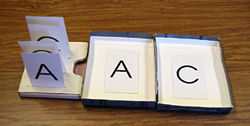
Use containers to organize materials (e.g., placing the various materials of an activity into separate containers, or arranging alphabet letters to be matched by standing them upright in a foam tray, rather than having them bunched together in a single container).
Limit the area (e.g., use masking tape to enclose specific areas for a student to vacuum).
- Visual Clarity: The purpose of visual clarity is to highlight the important information, concepts, specific parts of the instruction and key materials (1). The nature of the task is designed to prompt the student to focus on the important details of the “work job” (task/activity/assignment). These details are highlighted through colors, pictures, numbers or words. Providing visual clarity promotes student independence rather than relying upon adult guidance (2). The most concrete level of visual clarity is achieved by limiting the materials needed to complete the task successfully (e.g., removing unnecessary, irrelevant or extra materials) (2). Examples of visual clarity include:
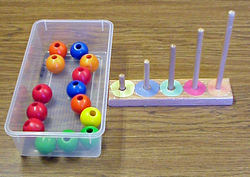
Color coding (e.g., assign each student a specific color and consistently use this color to teach the child to identify his environmental belongings more readily, including work areas, cubby space/locker, small group chair, snack/lunch seat, communication books, etc.
Labeling (e.g., for sorting tasks, highlighting openings on containers to make them more visually obvious).
Through the use of a visually structured teaching method, a student with autism can learn to complete various tasks/activities independently, i.e., without an adult’s physical or verbal prompt. Therefore many students with autism can engage in “independent work sessions” for various periods of time throughout their day, in any environment (home, school, work), and on any skill area, such as academic/curricular, daily living skills, recreation and leisure, etc.).
Conclusion
The structured teaching approach allows the student with autism to learn a process of focusing upon and following visual cues in various situations and environments, in order to increase his overall independent functioning. It is important to note that various instructional interventions, such as sensory integration, Picture Exchange Communication System-PECS, Greenspan’s Floortime, discrete trial, etc., can easily be incorporated into the structured teaching approach.
References
Division TEACCH. Division TEACCH Training Manual. revised January, 1998. Chapel Hill, NC
Division TEACCH. Visually Structured Tasks: Independent Activities for Students with Autism and Other Visual Learners. March 1996. Chapel Hill, NC
Harris, Sandra L. and Jan S. Handleman. Preschool Programs for Children with Autism. Austin, Pro-Ed, 1994
Johnson, Kathleen. “Autism 101” Training. CESA 6, Oshkosh, WI. March 16-17, 2000.
“Structured Teaching,” 15 August, 1998. Division TEACCH, Chapel Hill, NC https://www.unc.edu/depts/teacch/
Trehin, Paul. “Some Basic Information about TEACCH,” Autisme France. 23 March 2000. https://www.unc.edu/depts/teacch/
Acknowledgment
Written by Susan Stokes under a contract with CESA 7 and funded by a discretionary grant from the Wisconsin Department of Public Instruction.

